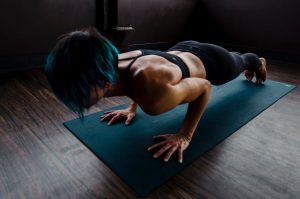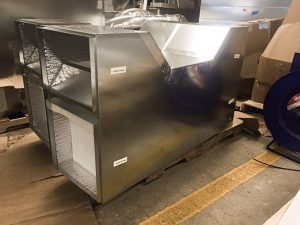The energy-efficient best bet for a heated studio.
 What’s the fuss over Hot Yoga? Also known as Bikram Yoga, the practice is held in heated studios to increase yoga’s effects on muscles and various systems of the body. Unfortunately, the heat and humidity desired by practitioners for detoxing the body through sweat can lead to unhealthy results if the building’s HVAC equipment is not up to the task. Before contracting, designing, or retrofitting a hot yoga studio—or perhaps even practicing at one—it’s important to understand that there’s more to preparing the environment than keeping the room at 105°F (40.5°C) with at least 40% relative humidity. Without a proper balance between stale air leaving and outdoor air coming in, the rest of the hot yoga equation—temperature, humidity, oxygen, and carbon dioxide levels—falls out of balance. At best, patrons will leave feeling less-than energized. At worst, the studio is left vulnerable to awful smells, infectious disease, mold, and possible structural issues if unchecked condensation is allowed to flourish.
What’s the fuss over Hot Yoga? Also known as Bikram Yoga, the practice is held in heated studios to increase yoga’s effects on muscles and various systems of the body. Unfortunately, the heat and humidity desired by practitioners for detoxing the body through sweat can lead to unhealthy results if the building’s HVAC equipment is not up to the task. Before contracting, designing, or retrofitting a hot yoga studio—or perhaps even practicing at one—it’s important to understand that there’s more to preparing the environment than keeping the room at 105°F (40.5°C) with at least 40% relative humidity. Without a proper balance between stale air leaving and outdoor air coming in, the rest of the hot yoga equation—temperature, humidity, oxygen, and carbon dioxide levels—falls out of balance. At best, patrons will leave feeling less-than energized. At worst, the studio is left vulnerable to awful smells, infectious disease, mold, and possible structural issues if unchecked condensation is allowed to flourish.
An Energy Recovery Ventilator (ERV) for humidity issues.
The answer to balancing a hot yoga studio’s environment is mechanical ventilation via an ERV. Not only will participants be exposed to a continuous supply of outdoor air, but the humidity will freshen as well. A superior unit will have folks breathing easier while saving the studio money by recovering the energy from the air on its way out to preheat the air entering the building.
ERV recommendations for Hot Yoga spaces.
ASHRAE standard 62 recommends 20 cfm per person for spaces such as hot yoga studios. While this works, Haglid EngineeringTM recommends 40 cfm to ensure a thorough venting of the space between classes. In such situations, Building Performance Equipment, Inc. (BPE) ERVs have been shown to provide thermal efficiency of 90 percent and up. Accordingly, payback on the unit can come in at less than one year.
Naturally, the size ERV you’ll need correlates to class space. Taking our recommendation of 40 cfm per person, you might be looking at a 1,000 cfm unit (BPE-XE-MIR-1000) for a studio of 25 students or a 2,000 cfm unit (BPE-XE-MIR-2000) for 50. Need higher? The 2000 model is stackable up to 20,000 cfm.

BPE-XE-MIR-2000 (BPE, Inc.)
Seek professional help to ventilate your hot yoga studio efficiently.
Hot yoga studios are tricky to run efficiently and safely from an HVAC standpoint. Fortunately, Haglid Engineering stands ready to assist owners and contractors in saving money and keeping clients by designing custom ventilation systems for simple to complex indoor environments. Give us a call!
Read this BPE-XE-MIR-2000 ERV solution for a hot yoga studio
Discover how a yoga studio saved $1,000 per month in utility costs.
Purchase a BPE-XE-MIR-2000 on Amazon
